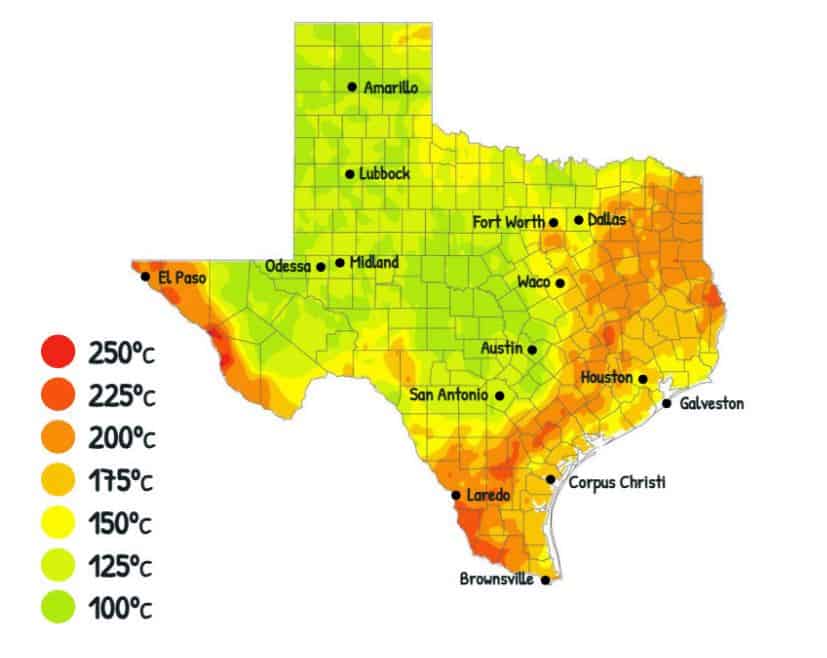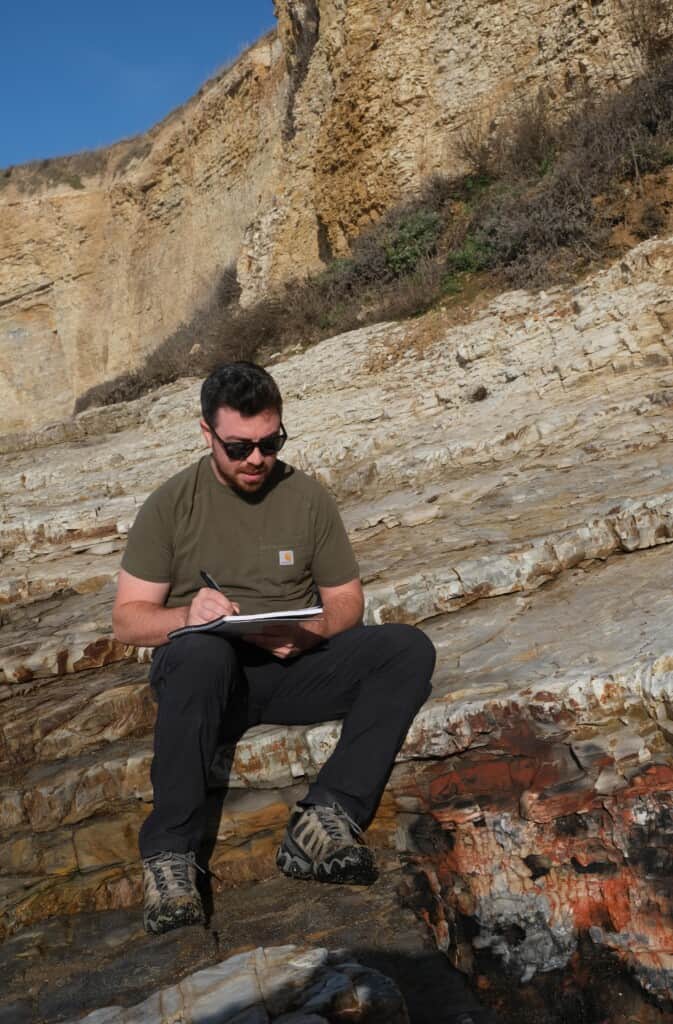Texas leads the country in energy production.1Wisian, K., Bhattacharya, S., & Richards, M. (May 1, 2023). The Texas geothermal resource: regions and geologies ripe for development. In The Future of Geothermal in Texas. (Beard, J. & Jones, B. A., Ed.). https://www.energy.gov/eere/articles/going-back-well-again-harnessing-geothermal-energys-potential The state produces the most oil and gas in the United States and is recognized as a world leader after the shale boom. Just below Texas’s surface, scientists estimate one million exajoules of heat for geothermal energy. However, Texas is not a conventional location for geothermal because there are no hydrothermal resources. So, geothermal’s history is short compared to other areas of the world. Most of the work in the state occurred in the 1970s and 1980s. Researchers mainly studied a subterranean zone along the Texas Gulf Coast. In the 1990s, there was a geothermal demonstration plant in Brazoria County. Overall during the latter decades of the 21st century, scientists researched and expanded the knowledge of geothermal in Texas allowing scientists today to have a strong foundation for the development of geothermal drilling and resource development in the state’s unique geologic setting.
Unconventional Geothermal Development Potential in Texas
The Texas Geothermal Energy Alliance published a recent report The Future of Geothermal in Texas: The Coming Century of Growth & Prosperity in the Lone Star State on geothermal opportunities in the State of Texas. The report highlights Texas’s unique opportunity to lead the country in unconventional geothermal energy production. Let’s hear a short summary of this very important report.
Participating authors include researchers from The University of Texas at Austin, Southern Methodist University, Rice University, Texas A&M University, and the University of Houston. The landmark study evaluates the size and potential scale of geothermal as an abundant clean energy resource in the State of Texas, as well as its potential to scale globally over the coming decades. Most importantly, the report provides a scientific basis for informed decision making as entities begin to consider increased development of geothermal in Texas, and provides a compelling roadmap to global decarbonization by 2050.2Beard, J.C., and Jones, B.A., eds. (2023, May 1). The Future of Geothermal in Texas. https://energy.utexas.edu/research/geothermal-texas
At 10 kilometers of depth or shallower, just about every point on earth has sufficient heat for power generation. This massive heat resource is viable for electricity production in much of Texas, including near its major population centers, at approximately 6.5 kilometers, a drilling depth typical in parts of the world within the oil and gas industry. In fact, analysis in The Future of Geothermal in Texas report and a prior related study concluded that it is likely hotter in the Texas subsurface than previously estimated, by as much as 15 percent. This difference is significant enough to improve both project economics, and technical feasibility of geothermal development in Texas.3Beard, J.C., and Jones, B.A., eds. (2023, May 1). “Executive Summary”. The Future of Geothermal in Texas. p. 2. https://energy.utexas.edu/research/geothermal-texas

Temperature of Texas geothermal resources at 6.5 kilometers depth. As mapped, much of the State is at or near conventional minimum viable temperatures for geothermal power generation. (Adapted from SMU Geothermal Laboratory)4Beard, J.C., and Jones, B.A., eds. (2023, May 1). The Future of Geothermal in Texas. https://energy.utexas.edu/research/geothermal-texas

The map of Texas shown here displays the subsurface temperature at an accessible depth to drill for a binary geothermal plant. Binary plants require rock temperatures to be between 125–150℃ (257–302 ℉). The map suggests that there is ample opportunity for binary geothermal plant development in a wide geographic range within Texas.5Beard, J.C., and Jones, B.A., eds. (2023, May 1). The Future of Geothermal in Texas. https://energy.utexas.edu/research/geothermal-texas
Application of Oil & Gas Technology to Geothermal in Texas
The legacy of the state as an oil and gas leader, both in technological development and in production, can help launch a geothermal industry in Texas. Oil and gas technology developed in the state is highly applicable and transferable to the historical challenges faced in designing economically feasible, enhanced geothermal systems (EGS).6Beard, J.C., and Jones, B.A., eds. (2023, May 1). The Future of Geothermal in Texas. https://energy.utexas.edu/research/geothermal-texas The report shares an important advantage in Texas: a plethora of abandoned oil wells. Drilling a borehole into the ground is a huge upfront cost for geothermal development, but Texas has a large number of existing oil and gas wells, many of which are abandoned or may be in the future. Many of these wells can be either repurposed for geothermal energy or used for the co-production of geothermal energy and hydrocarbons. In fact, many current field projects are exploring opportunities to retrofit abandoned oil wells for geothermal. Researchers project that the oil and gas industry could reduce the costs of geothermal development by 20–43% due to both their decades of experience in drilling and the number of existing wells in the state. Researchers project that in just four years, Texas has the ability to develop enough geothermal energy to provide the same amount of electricity and heat production as oil and gas is currently providing for the state.7Beard, J.C., and Jones, B.A., eds. (2023, May 1). The Future of Geothermal in Texas. https://energy.utexas.edu/research/geothermal-texas

Which factor listed is probably the most important to enable Texas to launch a geothermal industry?
Previous hydrothermal projects in the state that have aided development of regulatory rules to govern the new industry
Incorrect
There are no hydrothermal projects in Texas and regulatory oversight is still unsettled.
The legacy of the state as an oil and gas leader, both in technological development and in production
Correct
Career Spotlight: Sam Klarin

Academic Background
- B.S. Petroleum Engineering, The University of Texas at Austin
- M.S. Energy and Earth Resources The University of Texas at Austin
Sam Klarin is a recent graduate of the Energy and Earth Resources Master’s Program at UT Austin. His recent research looked at the resource availability of geothermal energy along Texas’ Gulf Coast region and East Texas. He integrated energy technologies from various areas within the energy sector, such as carbon capture and storage, CO2-plume geothermal, oil & gas, and hydrogen production, into his analysis to demonstrate geothermal’s crossover with many other industries. Sam specifically researched the Brazos protraction area (an offshore area in the Gulf of Mexico) and produced an economic analysis of its geothermal potential.

Sam received his Bachelor of Science degree from the Cockrell School of Engineering at UT Austin where he studied Petroleum & Geosystems engineering. His oil and gas drilling background prepared Sam to study similar geologic sites to research geothermal.
Image Credits
- Texas-geothermal-6.5-km-temps-FOGIT: The Future of Geothermal in Texas
- Wells of oppportunity: U.S. Dept. of Energy, Geothermal Technologies Office
- Sam Klarin, headshot: Sam Klarin
- Sam Klarin working in the field: Sam Klarin